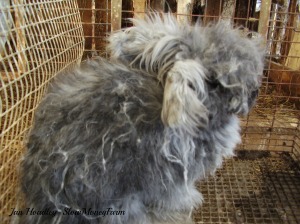 Once you have dealt with fly strike you will never forget it. Hot, damp conditions can lead to fly strike and contrary to what is sometimes stated it by itself is not a condition of neglect.
Once you have dealt with fly strike you will never forget it. Hot, damp conditions can lead to fly strike and contrary to what is sometimes stated it by itself is not a condition of neglect.
A purebred Rex doe in the rabbitry came down with fly strike – she was in a clean all wire cage, had a clean board to rest on when she wanted. I noticed a “death odor” around her and in checking under her tail, in the folds of the skin of the leg were live maggots. She apparently would rest against her water bottle, allowing the water to drip on her rump and down her hindquarters. This combined with warmer weather proved an ideal breeding ground for flies. The nature of the Rex fur traps the moisture next to the skin and in a very short time fly strike raised its head. I called two veterinarians, neither of which wanted to deal with it. The first didn’t have rabbit experience and the other recommended treating at home as they’d do the same things I could do.
Treatment involved gently holding the affected area under running water and flushing all the live maggots out. Unpleasant – absolutely! I’ve dealt with many conditions over the years but this was one I don’t care to ever repeat. They literally feed on the live animal’s flesh, and you need to get every one off the animal as deep into the wound as you can get without “digging.” Removing the maggots is essential…a bad enough it can kill the animal. Once you get all of them flushed out that you can see, take some petroleum jelly and liberally apply to the area. This smothers any that you didn’t get down in there.
Once the animal is relieved of live ones it is critical to keep her inside, dry and let her heal. If caught early it *will* heal up. It’s ugly, nasty and will scar but it will heal. It happens. Taking the animal to the vet results in a bill for doing what I just said…and as mentioned I called the vet and was refused treatment – many do not know rabbits and in many rural areas they’re considered disposable. Instead it meant treating her at home because “that’s all we’d do if you brought her in.”
Some animals seem more prone to flystrike than others. Prevention once the animal is healed involves stepping up fly control. Keep areas under cages DRY. If you have stack cages to to a feed and tack store and get Stall Dry, PDZ or other products used in horse stalls – simply sprinkle a little in there when you clean the cage. A bag will last you quite a long time and is a cheap investment. Never use lime where animals can come in contact. If you have hanging cages and clean the bedding underneath lime is fine – but if in the cage it can cause burns as it can be very caustic.
With a larger rabbitry at the time dry was critical. The manure for composting was good, as long as the bedding and all was dry. This meant turning it as often as possible – in the summer time that was light bedding and twice per day turning. This dried out leaving no moisture for flies to lay eggs in. Along with that use vanilla in the drinking water – which does help cut the flies. Some use fly sprays but I elected not to for the respiratory systems of the rabbits. Heavy use of fly bait, sticky traps, chickens under the cages to scratch the material around and eat bugs (as long as the chickens stay on the ground and don’t roost on top the cages, creating a mess!). Adopt the policy of zero tolerance for flies – if it flies it dies.
While this might be harsh, it’s a whole lot better than trying to hold a nine pound rex doe upside down and backwards (avoiding claws and kicks and keeping her calm so I could see what I was doing) in the kitchen sink. Perhaps the only creature that dislikes a bath more is a cat. Prevention is MUCH better than curing flystrike.
Keeping the area dry and fly free is effective against allowing flies to take hold. If there’s flies, animals and damp conditions then it can be a ticking time bomb until one of the animals is hit. IF it’s caught early they can recover, but if the injuries are too severe the animal can die or should be put down to prevent suffering.
Check animals twice a day – if there is *any* funny odor, if it looks like dandruff on the rabbit’s coat it might be fly eggs. Watching for this it is possible, once you know what they look like, to get that “dandruff” off before the fly eggs hatch. This is not just flakes of skin – it’s a tiny almost dust.
Much better is prevention. Dry, keep fans on rabbits when it gets much over 80 not only for flystrike but heat. A no fly zone is – in this case – a good thing!